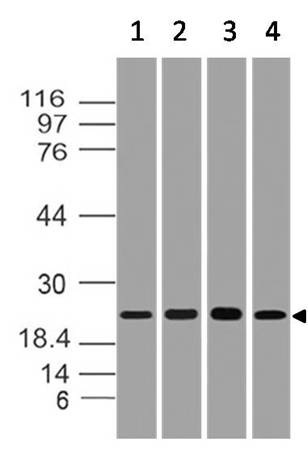Polyclonal antibody to Bag-1

Fig-1: Western blot analysis of Bag-1. Anti- Bag-1 antibody (20-1015) was used with 1:5000 dilution on (1) THP1, (2) Jurkat, (3) MCF-7 and (4) h Heart lysates.
Roll over image to zoom in
Shipping Info:
Order now and get it on Tuesday April 22, 2025
Same day delivery FREE on San Diego area orders placed by 1.00 PM
| Format : | Sera |
| Amount : | 50 µl |
| Isotype : | Rabbit IgG |
| Content : | 50 µl sera |
| Storage condition : | Store the antibody at 4°C, stable for 6 months. For long-term storage, store at -20°C. Avoid repeated freeze and thaw cycles. |
The BAG proteins are a family of chaperone regulators that modulate a number of diverse processes including proliferation, survival, stress responses, tumorigenesis, neuronal differentiation, growth arrest and. BAG proteins have been characterized as co-chaperones and interact with the chaperone heat shock proteins 70, both constitutive Hsc70 and inducible Hsp70. BAG proteins bind through their BAG domain to the ATPase domain of Hsc70/Hsp70, and can modulate either positively or negatively the functions of the Hsc70/Hsp70 chaperone proteins.The BAG domain has been shown to contribute to the anti-apoptotic activity of BAG- family proteins. The anti-apoptotic activities of BAG-family proteins may be dependent on their interactions with Hsc70/Asp70 and/or binding to Bcl-2. In addition to the conserved BAG domain, BAG-family proteins also contain additional domains which enable them to interact with specific target proteins or to target them to specific locations within cells. The BAG family contains at least six family members, including BAG-1 and its various isoforms [including BAG-1S, BAG-1M (RAP46/HAP46), and BAG-1L, BAG2, BAG3 (CAIR-1; Bis,), BAG4 (SODD), BAG5 and BAG6 (Scythe, BAT3).
WB: 1:1000-1:5000
For Research Use Only. Not for use in diagnostic/therapeutics procedures.
| Subcellular location: | Cytoplasm, Nucleus |
| Post transnational modification: | Ubiquitinated; mediated by SIAH1 or SIAH2 and leading to its subsequent proteasomal degradation. |
| Tissue Specificity: | Isoform 4 is the most abundantly expressed isoform. It is ubiquitously expressed throughout most tissues, except the liver, colon, breast and uterine myometrium. Isoform 1 is expressed in the ovary and testis. Isoform 4 is expressed in several types of tumor cell lines, and at consistently high levels in leukemia and lymphoma cell lines. Isoform 1 is expressed in the prostate, breast and leukemia cell lines. Isoform 3 is the least abundant isoform in tumor cell lines (at protein level). |
| BioGrid: | 107049. 143 interactions. |
|
There are currently no product reviews
|














.png)











